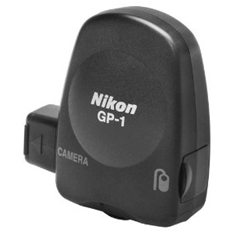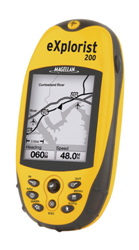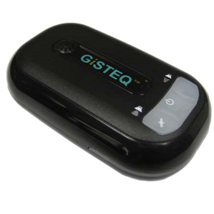Last night I began looking at Nikon’s GP-1 GPS Receiver that is designed to record GPS data directly to a D90, D300, D300S and other similarly classed cameras. I was looking at the device in a purely theoretical kind of way, since I would not need it until I acquire either a D90 or D300S camera, as the D60 does not support the direct data connection used by the device, the D90 barely does. My original conception of what this device is involved it sitting nearly on top of the hot shoe (external flash port), and perhaps it providing an additional port to pass power to a flash. No, that’s not quite how it works. The thing can be mounted on the hot shoe, but it does not use it, it connects by a 10 inch cable to the data port on the cameras and provides no additional port for a flash to be added. At $210 I question the value of this device. The only real benefit that this device has over a device that adds information about location to a picture after it is taken is that there is no next step, it is done immediately and seamlessly, but how good of a feature is that, really? GPS devices are known for being unreliable and this one is no exception to the rules of physics that cause that unreliable behavior. If you go in a building with the device, it won’t receive information or will give you bad information. Some other GPS devices that are designed for the same purpose (except do not talk to the camera directly) include a “hint” mode that you can use before entering a building, which causes it stick to the information it has so that it can geotag images taken in the building. One of the worst things about GPS is the ability for it to “jump” up to 50 feet because of an object bouncing the signal (accuracy is only about 10-15 ft even in an open field), this device will write that incorrect information directly to the picture, and there is no way to change it. As hard as it is to add information to EXIF, its worse to have to remove it. An external unit that does not write information directly to the camera will record a tracklog, which can be imported into many different types of software to do things such as create maps or apply an offset. That offset can be used to correct GPS positional data by hand. It is tedious, but the correct information will be used and you won’t have images that appear by their GPS data to have been taken in the middle of a lake, when you were really on a trail beside the lake. The only really positive attribute that I can think of for the GP-1 is that it is attached to the camera, so you always know that the information it has recorded is from where the camera was, give or take that 10 inch cable dangling it from the camera. One of the more obvious flaws that Nikon has even recorded in the manual is the absence of an on/off switch. The camera’s power state does not matter either, the device is still on and active, and drawing power from the camera. I feel that the worst trait of all on this device is that it sucks power away from the camera for its task, why can the device not have an independent power supply like flashes do?
In my quest for a GPS unit for my camera, I will be looking for something that is reliable, compact, discreet, fast and inexpensive (relative to the cost of the camera [should be more like 10% the cost, not 30%, I believe]). I would prefer to use devices made by my camera manufacturer, but I cannot do that when the only option is an inferior product to other products that are available on the market. I am presently looking at the GiSTEQ CD111 GPS Digital PhotoTracker. It is designed for use with cameras, since it has no independent display. It is a $75 device with no real display, it’s about the size of a battery for the D60 and it has its own independent power source that can operate it for 33 hours continuous operation. Cool thing about the device is once I have exhausted its battery, I can slide the thing into its cradle and it will charge. I don’t have to mess with batteries like I do for the Magellan. The device is as simple as that. It comes with software to tag images, but I will likely just stick with RoboGEO for that task.
|
|
|
|
|
|
Nikon GP-1 + Directly records data + Always near camera + No Display – No independent power source – No power switch – No method to correct data – Unitasker – data is only good for the photos – Expensive – Only works with certain cameras – Static data interval
|
+ Records tracklog (can be corrected) + On/Off Switch + Independent Power + Data for photos and other tasks + Works with all cameras – AA batteries – Unneeded display (battery drain) – Difficult battery door – Huge! – Clunky internal software – Static data interval |
+ Records tracklog + On/Off switch +Can turn on by vibration (no forgetting to use it) + Independent Power + Rechargeable Battery + Data for photos and other tasks + Small + No external display + Hint button + Works with all cameras +Configurable data interval |
|


